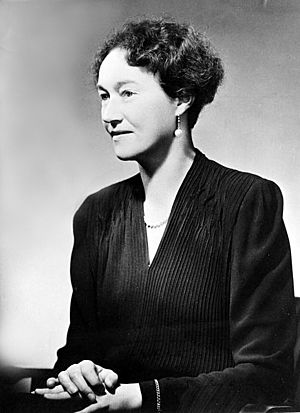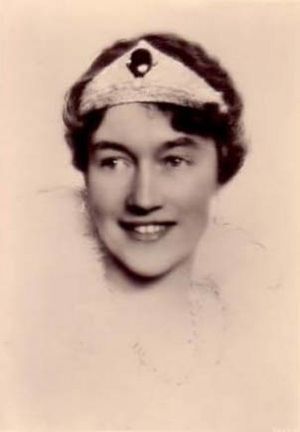Charlotte, Grand Duchess of Luxembourg facts for kids
Quick facts for kids Charlotte |
|||||
|---|---|---|---|---|---|

The Grand Duchess in 1942
|
|||||
| Grand Duchess of Luxembourg | |||||
| Reign | 14 January 1919 – 12 November 1964 | ||||
| Predecessor | Marie-Adélaïde | ||||
| Successor | Jean | ||||
| Prime ministers |
See List
|
||||
| Born | 23 January 1896 Berg Castle, Luxembourg |
||||
| Died | 9 July 1985 (aged 89) Fischbach Castle, Fischbach, Luxembourg |
||||
| Burial | Notre-Dame Cathedral | ||||
| Spouse | Prince Felix of Bourbon-Parma (m. 1919; died 1970) | ||||
| Issue |
|
||||
|
|||||
| House | Nassau-Weilburg | ||||
| Father | William IV, Grand Duke of Luxembourg | ||||
| Mother | Infanta Marie Anne of Portugal | ||||
| Religion | Catholicism | ||||
Charlotte (born Charlotte Adelgonde Elisabeth Marie Wilhelmine; 23 January 1896 – 9 July 1985) was the Grand Duchess of Luxembourg. She ruled from 14 January 1919 until she stepped down on 12 November 1964.
She became Grand Duchess after her older sister, Marie-Adélaïde, gave up the throne. This happened because of political pressure related to Marie-Adélaïde's actions during the German occupation in World War I. A public vote later decided that Luxembourg would keep its monarchy with Charlotte as its leader.
Charlotte married Prince Felix of Bourbon-Parma on 6 November 1919. They had six children together. When Germany invaded Luxembourg in 1940 during World War II, Charlotte had to leave the country. She lived in France, Portugal, Great Britain, and North America. While in Britain, she spoke to the people of Luxembourg on the radio. She returned home in April 1945.
She stepped down from her role in 1964. Her son, Jean, took over as Grand Duke. Charlotte passed away from cancer on 9 July 1985.
Contents
Becoming Grand Duchess
Charlotte was born at Berg Castle in Luxembourg. She was the second daughter of Grand Duke William IV and his wife, Marie Anne of Portugal.
Her older sister, Marie-Adélaïde, became Grand Duchess before her. However, Marie-Adélaïde's actions became controversial. Many people felt she was too friendly with the Germans during World War I. Because of this, she was forced to give up her throne on 14 January 1919.
After her sister's abdication, Luxembourg adopted a new constitution. On 28 September 1919, the people of Luxembourg voted in a special election. A large majority (77.8%) voted to keep the monarchy with Grand Duchess Charlotte as their head of state. However, the new constitution limited the monarch's powers.
Leading During World War II
By 1935, Charlotte had sold her family's old palaces in Germany. These included Biebrich Palace and Schloss Weilburg.
When World War II began, the Grand Ducal family had to leave Luxembourg. They left just before Nazi troops arrived. Germany broke Luxembourg's neutrality on 9 May 1940. Charlotte and her family were at Colmar-Berg at the time. She quickly met with her top ministers. They all decided to seek protection in France. Charlotte called this a hard but necessary choice.
The family first stayed at a castle in southwestern France. But the German army quickly moved into France. France then surrendered, and its government could no longer protect the exiled Luxembourg government. Charlotte and her ministers were allowed to travel through Spain without stopping. They then moved on to Portugal.
The Germans offered to let Charlotte return to her role. But she refused. She remembered her sister's difficult experience staying in Luxembourg during the First World War under German occupation. By 29 August 1940, Grand Duchess Charlotte was in London. From there, she began making encouraging radio broadcasts to her homeland using the BBC.
Later, she traveled to the United States and Canada. Her children continued their schooling in Montreal. Charlotte met with President Roosevelt several times. He encouraged her to travel across the U.S. and speak out against isolationism. This was a strong political idea in the U.S. until the Pearl Harbor attacks. Meanwhile, Luxembourg was taken over by Germany. Luxembourgers were forced to speak German and join the German army.
In 1943, Grand Duchess Charlotte and the Luxembourg government settled in London. Her BBC broadcasts became more regular. She became a symbol of hope for the resistance movements in Luxembourg. The Grand Ducal family lived in North America for a time. They stayed first in Brookville, Long Island, and then in Montreal. The Grand Duchess visited Washington D.C. and toured the U.S. to keep Luxembourg in the minds of the Allies.
Charlotte's younger sister, Antonia, and her brother-in-law were exiled from Germany in 1939. In 1944, Antonia was captured in Hungary when the Germans invaded. She was sent to Dachau and later to Flossenbürg. She survived, but her health was badly damaged. Meanwhile, from 1942, Grand Duchess Charlotte's oldest son, Jean, joined the British Army. He served as a volunteer in the Irish Guards.
After the War and Abdication
After the war, Charlotte was very active in public life. She helped raise Luxembourg's standing on the world stage. She hosted visits from many foreign leaders and important people. These included Eleanor Roosevelt (1950), Queen Juliana of the Netherlands (1951), and King Baudouin of Belgium (1959). She also visited Pope Pius XII (1950) and John F. Kennedy (1963).
On 12 November 1964, Grand Duchess Charlotte stepped down from her role. She gave the throne to her son, Jean. He then ruled until his own abdication in 2000.
Charlotte passed away at Schloss Fischbach on 9 July 1985, from cancer. She was buried in the Ducal Crypt of the Notre-Dame Cathedral in Luxembourg City.
A statue of Grand Duchess Charlotte stands in Place Clarefontaine in Luxembourg City.
Marriage and Children
On 6 November 1919, in Luxembourg, Charlotte married Prince Felix of Bourbon-Parma. He was her first cousin on her mother's side. Both Charlotte and Felix were grandchildren of King Miguel of Portugal. After their marriage, their children were given the title of Royal Highness.
The couple had six children:
- Jean, Grand Duke of Luxembourg (1921–2019), who married Princess Joséphine-Charlotte of Belgium
- Princess Elizabeth of Luxembourg (1922–2011)
- Princess Marie Adelaide of Luxembourg (1924–2007)
- Princess Marie Gabrielle of Luxembourg (1925–2023)
- Prince Charles of Luxembourg (1927–1977)
- Princess Alix of Luxembourg (1929–2019)
Honours
Charlotte received many honours from Luxembourg and other countries. These awards showed her importance and the respect she earned.
- National honours
 Luxembourg:
Luxembourg:
- Knight Grand Cross of the Order of the Gold Lion of the House of Nassau
- Recipient of the Luxembourg War Cross
- Foreign honours
 Kingdom of Albania
Kingdom of Albania
- Knight Grand Cross of the Order of Fidelity (1931)
- Austria
 Austrian Imperial Family: Dame of the Order of the Starry Cross, 1st Class
Austrian Imperial Family: Dame of the Order of the Starry Cross, 1st Class Austrian Republic: Grand Cross of the Decoration for Services to the Republic of Austria
Austrian Republic: Grand Cross of the Decoration for Services to the Republic of Austria
 Denmark: Knight of the Order of the Elephant - 21 March 1955
Denmark: Knight of the Order of the Elephant - 21 March 1955 France: Grand Cross of the Legion of Honour - 22 June 1923
France: Grand Cross of the Legion of Honour - 22 June 1923 Holy See:
Holy See:
- Dame Grand Cross of the Order of Pius IX
- Cross of Honour of the "Pro Ecclesia et Pontifice"
- The Golden Rose
- Italy:
 Parmese Ducal Family: Dame Grand Cross of the Sacred Military Constantinian Order of Saint George
Parmese Ducal Family: Dame Grand Cross of the Sacred Military Constantinian Order of Saint George
 Monaco: Grand Cross of the Order of Saint-Charles - 20 January 1949
Monaco: Grand Cross of the Order of Saint-Charles - 20 January 1949 Nazi Germany: Grand Officer of the Order of Social Welfare, Special Class
Nazi Germany: Grand Officer of the Order of Social Welfare, Special Class Netherlands: Knight Grand Cross of the Order of the Netherlands Lion
Netherlands: Knight Grand Cross of the Order of the Netherlands Lion Norway: Knight Grand Cross with Collar of the Order of St. Olav - 1964
Norway: Knight Grand Cross with Collar of the Order of St. Olav - 1964 Portugal:
Portugal:
- Dame Grand Cross of the Order of the Tower and Sword - 29 September 1933
- Grand Cross of the Sash of the Two Orders - 23 January 1949
 Spain : Dame Grand Cross of the Royal and Distinguished Order of Charles III
Spain : Dame Grand Cross of the Royal and Distinguished Order of Charles III Sweden: Member of the Order of the Seraphim - 14 April 1939
Sweden: Member of the Order of the Seraphim - 14 April 1939 Thailand: Dame of the Order of the Royal House of Chakri - 17 October 1965
Thailand: Dame of the Order of the Royal House of Chakri - 17 October 1965
Gallery
-
The old Berg Castle (demolished 1906), Mersch, central Luxembourg, where Charlotte was born.
See also
 In Spanish: Carlota de Luxemburgo para niños
In Spanish: Carlota de Luxemburgo para niños





